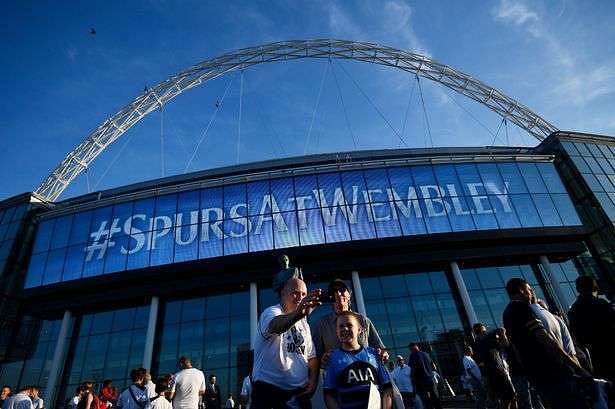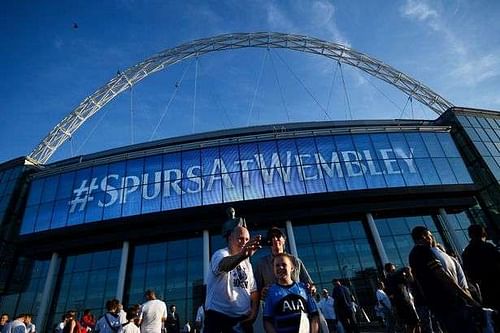
Wembley or Woembley: How Tottenham's stadium move will impact their season
The Northumberland Development Project is one that will effectively drive Tottenham Hotspur out of their cosy home stadium, albeit temporarily. The project overlooks the construction of a brand new stadium that will essentially replace the current White Hart Lane stadium.
Wembley Stadium, in London, has been nominated to provide refuge for The Lilywhites and will be their home stadium for the 2017-18 season. Home to the English national football team, Wembley will be their base for the upcoming season and will bring with it a different set of potential pros and cons that are bound to affect the team’s challenge for the coveted English Premier League title.
Pros
Ticketing revenue increases
Tottenham’s makeshift home stadium, Wembley, can house close to 90,000 people at full capacity, juxtaposed to the modest full capacity of 36,000 that White Hart Lane had to offer. The ability to host more than twice the usual number of fans will surely accentuate ticket sales like never before, allowing the club to pump in more revenue.
Some of these funds could even be reserved for the upcoming transfer windows. More revenue could suitably assist their plans of beefing up the squad or help the club invest in other sectors. Increased capital will only make Mauricio Pochettino’s men a greater force to reckon with.
Greater Home Support
A steep increase in supporters during home games will also add to Spurs’ efforts by giving them a psychological edge over visiting opponents. Spurs’ 2nd-place finish in the 2016-17 season marked their best league position since the 1962-63 season and they will hope to cripple touring teams with a lethal combination of form and enhanced crowd support.
Visiting teams will be certain to face greater belligerence from Spurs with the additional fan support bellowing them on. Even the better sides in the league can be expected to grow unnerved during home games.
Improvement in facilities
Wembley Stadium, which was opened in 2007 and built over a period of four years(2003-07) is a much newer, technologically superior and thoroughly more advanced stadium in terms of infrastructure than the team’s previous residence – White Hart Lane, which was opened in 1899 and built in 1898.
Technologically enhanced infrastructure coupled with improved amenities could tip the scales in favour of Spurs, who surprised many with their second-placed finish in the league during the 2016-17 season. They will be determined to pose an even greater threat in the upcoming 2017-18 season, set to begin in less than a month.
The additional glory of being back at the famous Wembley arena might further bolster an enthusiastic and energetic Tottenham side in their league conquest.
Perfect Launchpad
The behemoth, 90,000-seater Wembley Stadium has been dubbed the largest football stadium in England, the largest stadium in the UK and the second-largest stadium in all of Europe. This glorious edifice also plays host to rugby matches and music concerts.
If Tottenham can capitalise on their form from last season, Wembley, in all its glory, can prove to be the perfect launchpad for the club which could help them leap into the topmost tier of English football and effectively expand the ‘Big 5’ into the ‘Big 6’.
Cons
Abominable record at Wembley
Manager Mauricio Pochettino will be tormented by the record his team hold at Wembley. Having won a mere two crucial games out of nine that the Spurs have played at Wembley since its inception in 2007, the club’s supporters and stakeholders can only pray that their team shrug off the alleged curse and rise, reinvigorated.
Their only victories at this venue have come against CSKA Moscow during the 2016 Champions League, who they trumped 3-1, and fellow Londoners Chelsea FC, almost a decade ago, in the 2008 League Cup final.
Their seven other games have yielded one draw, against Gent in the Europa League earlier this year, and six ominous defeats to sides including Chelsea, Manchester United, Monaco and Portsmouth.
New set of challenges
The Hugo Lloris led side will be wise to remember that a new stadium is bound to take some getting used to, hindering their desire to hit the ground running and carrying on with their momentum. Their new home is not just bigger in terms of infrastructure, but also in terms of ground dimensions. The Wembley field measures 105 by 69 metres (115 by 75 yards) in comparison to White Hart Lane’s 100 by 66 metres (110 by 72 yards).
While these may seem like negligible contrast, it has been known to cause problems in the past. When their North London rivals Arsenal played at Wembley, they too struggled with similar issues, with their manager Arsene Wenger going on to claim that it was “a nightmare”.
"It was a nightmare. In hindsight, it was the wrong decision," Wenger said. "We decided to go to Wembley but we didn't feel at home. The pitch was bigger, the ground was different and for the English players it was something completely unusual,” he added.
Further, every stadium is best expressed by its atmosphere, and Wembley promises to provide a spectacular one at that. It will, however, be different from the one that urged the team back at White Hart Lane. Ranging from dressing rooms to audio levels on the pitch, change is the only constant. The players will find themselves forced to channelize a fraction of their momentum into absorbing the new conditions.
The players will be conscious of this limitation and will need to overcome it while trying to win the league simultaneously. This will prove to be a challenge for even the best in the world.
Disruption in rhythm
Tottenham Hotspur are coming out of arguably their best season in a very long time and would love to pick up from where they signed off at the end of the 2016-17 season. Unfortunately for them, they will now have to ply their trade in a different arena, just a few miles away.
Change can be just as much of an impediment, as it is a constant. The more troubling thought is that the team are moving temporarily from their old fortress into a newer environment which hasn’t yielded much to them in the past. This move will demand solid resolve from the players as well as the management while they struggle to maintain their form and rhythm from last season.
White Hart Lane was nestled deep in North London leaving the Tottenham side and their fans embroiled in an incessant tussle with their rivals in the North, Arsenal. Now, however, they must journey north-west towards a different part of London, closer to other clubs and their corresponding fandoms. This too could play a part in the mental setup of the team.
To Conclude
Tottenham Hotspur will inevitably be plagued by a host of issues as Pochettino and his men look to kick-start their season fuelled by the inertia of their last, in a completely new arena that they will aspire to make their own.
It is a time of transition for the club. One that might catapult them permanently into the same league as the bigger clubs, or conversely, cruelly undo their last season’s achievements and everything they had built until this moment.
Only time will tell how the Spurs emerge from this metamorphosis, but one thing is for sure.
The upcoming season is going to be a cracker.


